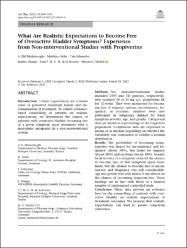| dc.contributor.author | Müderrisoğlu, A. Elif | |
| dc.contributor.author | Oelke, Matthias | |
| dc.contributor.author | Schneider, Tim | |
| dc.contributor.author | Murgas, Sandra | |
| dc.contributor.author | de la Rosette, Jean J. M. C. H. | |
| dc.contributor.author | Michel, Martin C. | |
| dc.date.accessioned | 2022-12-12T11:31:41Z | |
| dc.date.available | 2022-12-12T11:31:41Z | |
| dc.date.issued | 2022 | en_US |
| dc.identifier.citation | Müderrisoğlu, A. E., Oelke, M., Schneider, T., Murgas, S., de la Rosette, J. J. M. C. H. ve Michel, M. C. (2022). What are realistic expectations to become free of overactive bladder symptoms? Experience from non-interventional studies with propiverine. Advances in Therapy, 39(6), 2489-2501. https://doi.org/10.1007/s12325-022-02114-4 | en_US |
| dc.identifier.issn | 0741-238X | |
| dc.identifier.issn | 1865-8652 | |
| dc.identifier.uri | https://doi.org/10.1007/s12325-022-02114-4 | |
| dc.identifier.uri | https://hdl.handle.net/20.500.12511/10111 | |
| dc.description.abstract | Plain Language Summary Unmet expectations are a major reason why patients with overactive bladder syndrome discontinue treatment. To enable evidence-based counselling of patients on realistic expectations, we have determined the chance that patients with overactive bladder become free of urgency, incontinence, voiding frequency, and nocturia. Two non-interventional studies included 1335 and 745 patients, respectively, who received 30 or 45 mg q.d. propiverine ER for 12 weeks. Analyses were also performed in subgroups defined by basal symptom severity, age, and gender. The probability of becoming symptom-free was largest for incontinence and voiding frequency (about 50%), but lesser for urgency and nocturia (about 20%). Greater basal severity of a symptom reduced the chance to become free of that symptom upon treatment, but the chance to become free of incontinence and frequency was still considerable. Age and gender had only minor if any effects on the chance of becoming symptom-free. These data provide an evidence base for the counselling of patients with overactive bladder on realistic expectations of treatment outcomes. We propose that realistic expectations can lead to greater long-term adherence.
Introduction Unmet expectations are a major cause of perceived treatment failure and discontinuation of treatment. To enable evidence-based counselling of patients on realistic expectations, we determined the chance of patients with overactive bladder becoming free of a given symptom upon treatment with a muscarinic antagonist in a non-interventional setting. Methods Two non-interventional studies included 1335 and 745 patients, respectively, who received 30 or 45 mg q.d. propiverine ER for 12 weeks. They were monitored for becoming free of urgency, urinary incontinence, frequency, or nocturia. Analyses were also performed in subgroups defined by basal symptom severity, age, and gender. Categorical data are shown as a percentage of the respective population. Continuous data are expressed as means or as median depending on whether the variability was considered to exhibit a normal distribution. Results The probability of becoming symptom-free was largest for incontinence and frequency (about 50%), but lesser for urgency (about 20%) and nocturia (about 10%). Greater basal severity of a symptom reduced the chance to become free of that symptom upon treatment, but the chance to become free of incontinence and frequency was still considerable. Age and gender had only minor if any effects on the chance of becoming symptom-free. These findings are in line with those of a limited number of randomized controlled trials. Conclusion These data provide an evidence base for the counselling of patients with overactive bladder on realistic expectations of treatment outcomes. We propose that realistic expectations can lead to greater long-term adherence. | en_US |
| dc.description.sponsorship | Apogepha | en_US |
| dc.language.iso | eng | en_US |
| dc.publisher | Springer | en_US |
| dc.rights | info:eu-repo/semantics/openAccess | en_US |
| dc.rights | Attribution-NonCommercial 4.0 International | * |
| dc.rights.uri | https://creativecommons.org/licenses/by-nc/4.0/ | * |
| dc.subject | Overactive Bladder Syndrome | en_US |
| dc.subject | Patient Counselling | en_US |
| dc.subject | Propiverine | en_US |
| dc.subject | Success Rate | en_US |
| dc.subject | Treatment | en_US |
| dc.title | What are realistic expectations to become free of overactive bladder symptoms? Experience from non-interventional studies with propiverine | en_US |
| dc.type | article | en_US |
| dc.relation.ispartof | Advances in Therapy | en_US |
| dc.department | İstanbul Medipol Üniversitesi, Tıp Fakültesi, Dahili Tıp Bilimleri Bölümü, Tıbbi Farmakoloji Ana Bilim Dalı | en_US |
| dc.department | İstanbul Medipol Üniversitesi, Tıp Fakültesi, Cerrahi Tıp Bilimleri Bölümü, Üroloji Ana Bilim Dalı | en_US |
| dc.authorid | 0000-0002-6308-1763 | en_US |
| dc.identifier.volume | 39 | en_US |
| dc.identifier.issue | 6 | en_US |
| dc.identifier.startpage | 2489 | en_US |
| dc.identifier.endpage | 2501 | en_US |
| dc.relation.publicationcategory | Makale - Uluslararası Hakemli Dergi - Kurum Öğretim Elemanı | en_US |
| dc.identifier.doi | 10.1007/s12325-022-02114-4 | en_US |
| dc.institutionauthor | Müderrisoğlu, A. Elif | |
| dc.institutionauthor | de la Rosette, Jean J. M. C. H. | |
| dc.identifier.wosquality | Q2 | en_US |
| dc.identifier.wos | 000772705700001 | en_US |
| dc.identifier.scopus | 2-s2.0-85127474380 | en_US |
| dc.identifier.pmid | 35325367 | en_US |
| dc.identifier.scopusquality | Q1 | en_US |



















